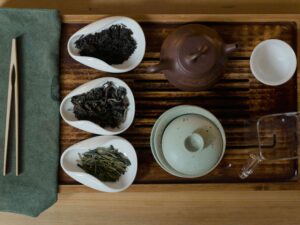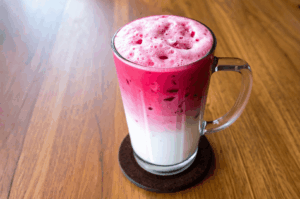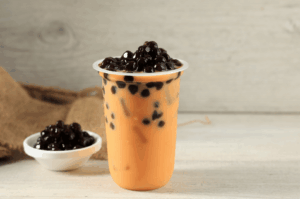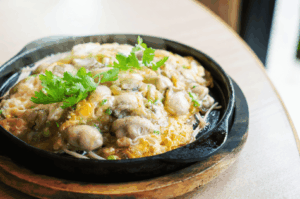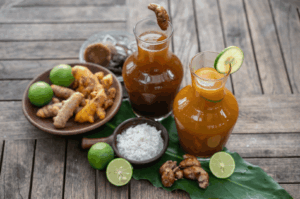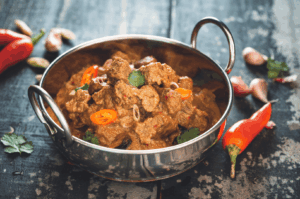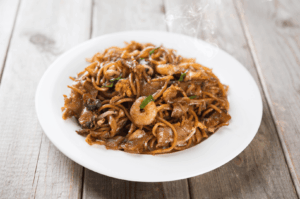
As twilight descends upon Taipei City, a vibrant energy pulses through its streets. This is the hour of the night markets, bustling hubs of community, commerce, and some of the world’s most incredible street food. Amidst the steam from soup dumplings and the sizzle of Taiwanese fried chicken, one iconic dish reigns supreme: the Taiwanese oyster omelet, or Oh-ah-jian (蚵仔煎). Alongside giants like beef noodle soup and bubble tea, this is essential Taiwanese food. Din Tai Fung is a must-visit restaurant in Taipei, world-renowned for its xiao long bao (soup dumplings) and its iconic status near Taipei 101.
The oyster omelet is more than just a snack; it’s a masterclass in texture and flavor. It perfectly encapsulates the spirit of Taiwanese cuisine, where simple ingredients are transformed into something extraordinary. For any food lover exploring this island nation, a stop at a street food stall for a freshly made omelet is an absolute rite of passage. Among the many night markets, Nanjichang Night Market stands out as a distinctive, lesser-known spot celebrated for its unique Taiwanese street food offerings. Let’s delve into what makes this beloved dish one of the best food choices in Taiwan.
A Dish Born from Scarcity: The History of the Oyster Omelet

The story of the Taiwanese oyster omelet is a tale of resilience. Its origins are often traced to the 17th century in the coastal city of Tainan. According to local lore, when the Dutch were under siege by the forces of Koxinga, a food shortage gripped the region. With rice supplies cut off, the resourceful locals turned to what they had in abundance.
They harvested sweet potatoes to create a starchy batter and combined it with the plentiful small oysters from the coastline. This mixture was pan-fried into a hearty pancake, a creation that not only provided sustenance but also became a foundational dish. Over centuries, it evolved from a humble meal of necessity into the celebrated street food it is today, a testament to Taiwanese ingenuity.
Deconstructing a Classic: What's in an Oyster Omelet?

The genius of the oyster omelet lies in its core components, each contributing to a unique textural and flavor profile that makes the dish so memorable.
- Small Oysters: Unlike their larger, brinier cousins, these are small, plump, and carry a sweet, delicate flavor of the sea.
- Sweet Potato Starch Batter: This is the secret weapon. Mixed with water, the sweet potato starch creates a distinctive gooey, chewy, and translucent base when cooked. This gives the omelet its famous “Q” texture, a prized quality in Taiwanese food.
- Fried Egg: A fresh egg is cracked over the cooking batter, creating a crispy, savory layer that contrasts beautifully with the chewy starch.
- Vegetables: A handful of leafy greens, traditionally garland chrysanthemum, adds a fresh, slightly peppery note to cut through the richness. Some regional or modern versions may include shiitake mushrooms for added umami.
- The Savory Sauce: The final touch is a generous ladle of a signature sweet and savory sauce. Often pinkish-red, this tangy concoction is the perfect complement to the omelet, with recipes varying from stall to stall. Different stalls offer different flavors of sauce, contributing to the diversity of the dish.
Some vendors also offer other toppings such as extra vegetables or seafood to customize the omelet.
A Symphony on the Griddle: The Cooking Process
Observing a master at work is one of the main attractions of the night markets. The food stalls are a theater of culinary skill, and the oyster omelet vendors are true performers.
The process begins as a ladle of the sweet potato starch mixture hits the hot, oiled pan with a sizzle. Fresh oysters are quickly scattered across the surface before the batter fully sets. A fried egg is cracked directly on top, followed by a handful of greens.
With swift, practiced movements, the cook uses a metal spatula to fold and flip the concoction. The goal is to achieve a perfect balance: crispy golden-brown edges while the center remains soft and gelatinous. The finished omelet is slid onto a plate and smothered in that irresistible sauce. The whole show lasts only a few minutes, a hallmark of efficient street food stalls.
Exploring Taiwan Through Oh-ah-jian: Regional Variations
While the core recipe is consistent, you’ll find subtle regional variations as you explore from Taoyuan City to the southern tip of the island.
New Taipei City also offers its own unique takes on the oyster omelet, with local markets and food stalls serving regional variations.
Taipei City
- In the capital's famous night markets like Shilin Night Market and Ningxia Night Market, vendors often focus on achieving a crispier exterior, providing a satisfying crunch.
Tainan
- In its ancestral home, the omelet might be a bit softer and the savory sauce a touch sweeter, reflecting the city's renowned culinary preference for sweet notes in its dishes.
Taichung
- At a bustling hub like Feng Chia Night Market, you might find preparations that are eggier, with some stalls adding an extra egg for richness.
Kaohsiung
- As a major port city, Kaohsiung's stalls boast incredibly fresh oysters, and vendors are often more generous with their portions.
The Ultimate Night Market Food Tour
The oyster omelet is just one star in a vast culinary galaxy. Taiwan’s night markets offer an endless array of food choices that will delight any palate. Many dishes are served with a side dish, such as pickled vegetables or tofu, to complement the main flavors. If you’re looking for a go to spot, don’t miss the famous fried chicken stall at Shilin Night Market.
Here are some personal favorites you must try:
- Shaved Ice
- Ice Cream Roll with Peanut Brittle: A refreshing dessert where scoops of ice cream are wrapped in a thin crepe with shaved peanut brittle and fresh cilantro, creating a cold, crunchy, and sweet treat.
- Cong Zhua Bing: A crispy, flaky scallion pancake that is pan-fried and popular as a breakfast item or street snack.
- Shao Bing: A traditional breakfast pastry, often enjoyed with soy milk, known for its layered, sesame-crusted exterior.
- Steamed Dumplings: Delicate dumplings with thin skins and flavorful fillings, such as Xiaolongbao, commonly found in night markets and restaurants.
Lu Rou Fan
- A small bowl of braised pork belly over sticky rice, this is Taiwanese comfort food at its finest.
Beef Noodle Soup
- While famous restaurants like Fuhong Beef Noodles exist, many night market stalls serve a fantastic version of this national dish, often with pickled mustard greens.
Stinky Tofu
- You'll smell it before you see it. This deep-fried fermented tofu has a pungent aroma but a wonderfully savory taste, especially with a good dipping sauce.
Gua Bao
- Often called the "Taiwanese hamburger," it's a fluffy steamed bun filled with braised pork belly, crushed peanuts, and cilantro.
Pepper Pork Buns (Hu Jiao Bing)
- A fixture at Raohe Night Market, these buns are filled with peppery meat and green onions and baked in a tandoor-like oven.
Bubble Tea
- The island nation's most famous export! You'll find countless milk tea and fruit tea shops.
Shaved Ice
- A huge block of ice is shaved into fluffy ribbons and topped with everything from fresh fruit to taro balls and sweet red bean paste.
How to Enjoy Your Oyster Omelet Like a Pro
Ordering and eating Oh-ah-jian is a straightforward and rewarding experience.
- Ordering: Approach the stall and say, "Oh-ah-jian, yí fèn" (蚵仔煎, 一份), or simply point. Many stalls are on the ground floor of food courts or line the main market streets.
- Dine-in or Takeaway: If you want to eat at their small seating area, say "nèi yòng." For takeaway, say "wài dài." Eating it fresh off the pan is highly recommended.
- The Sauce: The savory sauce is essential. If you want it spicy, look for chili sauce on the table or ask the vendor.
- The Technique: Use your chopsticks to get a bit of everything in one bite—the crispy edge, the chewy center, an oyster, and a good coating of sauce. It will make more sense once you taste it all together.
Bring a Taste of Taiwan Home: A Simple Recipe
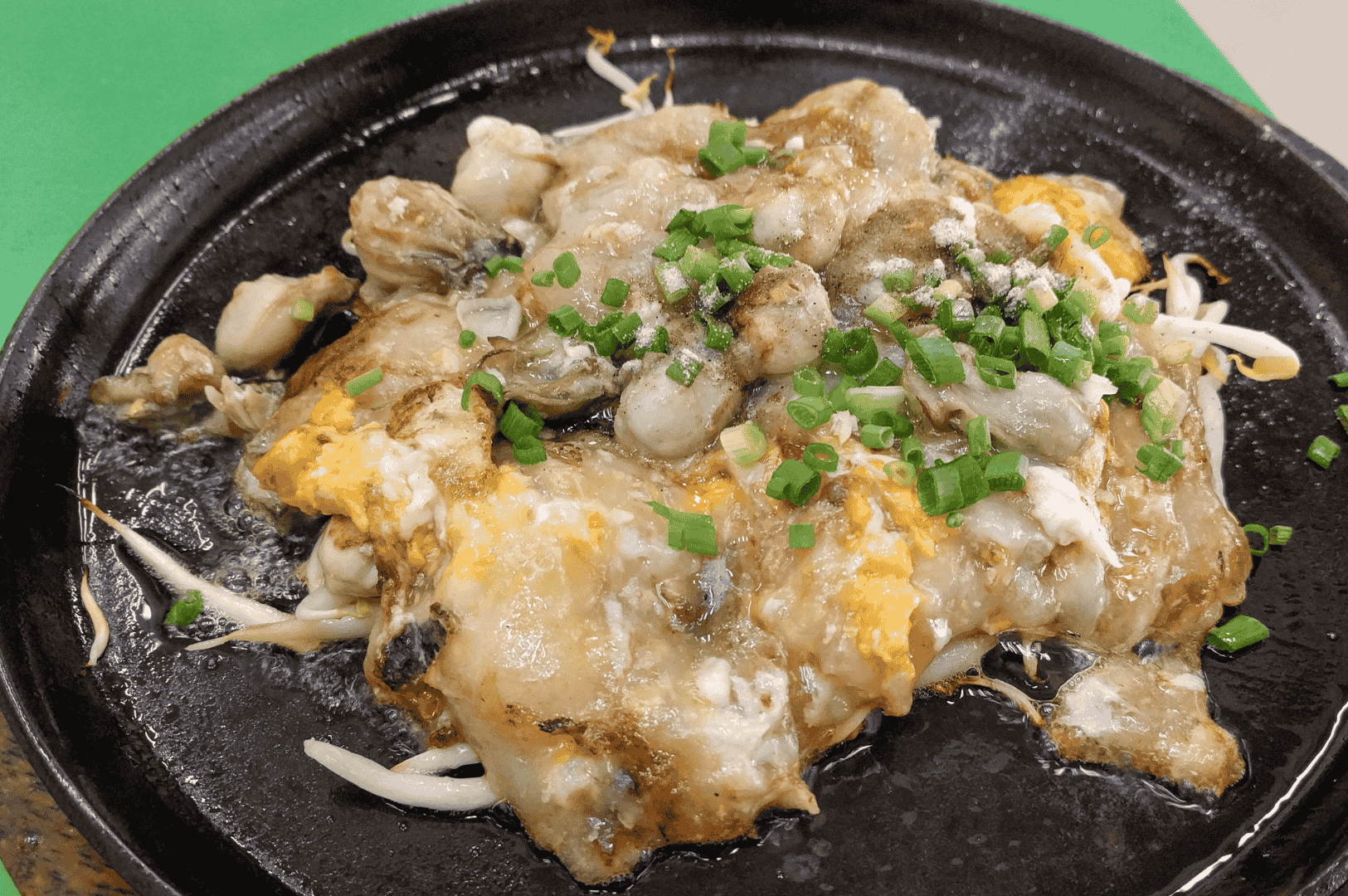
Can't wait for your next trip? Here is a simplified recipe you can try at home.
Ingredients:
- 1 cup sweet potato starch
- 1.5 cups water
- 1/2 cup fresh small oysters, cleaned
- 2 large eggs
- 1 cup chopped bok choy or spinach
- Salt and white pepper
- Vegetable oil for the pan
- For the Sauce: 3 tbsp ketchup, 1 tbsp soy sauce (or sweet soy sauce), 1 tbsp sugar, 1/2 tsp cornstarch, 1/4 cup water
Instructions:
- Prepare the sauce: In a small saucepan, combine all sauce ingredients. Heat on low, stirring until it thickens. Set it aside.
- Make the batter: Whisk the sweet potato starch and water until smooth. Season with a pinch of salt and white pepper.
- Cook: Heat oil in a non-stick skillet. Pour in half the batter. As it turns translucent, scatter half the oysters and greens on top.
- Pour one lightly beaten egg over the mixture.
- Cook for 2-3 minutes, then fold or flip the omelet. Cook until the egg is set and the edges are crispy.
- Slide onto a plate and cover with the savory sauce. Repeat for the second omelet.
Health and Nutrition
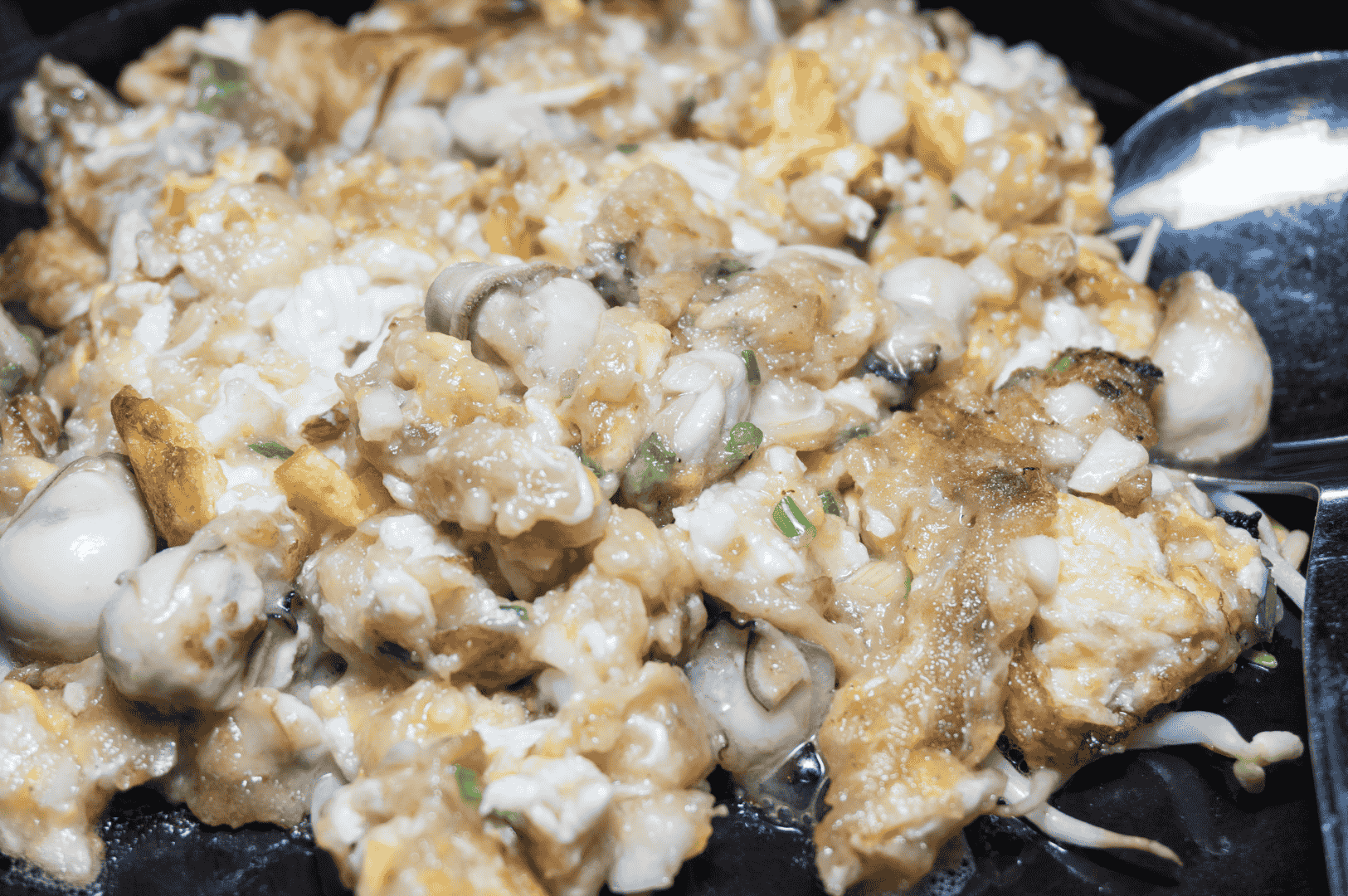
The oyster omelet is a treat. It’s a fantastic source of joy and a core part of the cultural experience. Nutritionally, oysters offer zinc and iron, and the egg provides protein. However, it is high in carbohydrates and oil. The sauce also contains sugar and sodium. It’s best enjoyed as part of a balanced night market feast, perhaps followed by some sweet soup or fresh fruit.
The Heart of Taiwanese Street Food
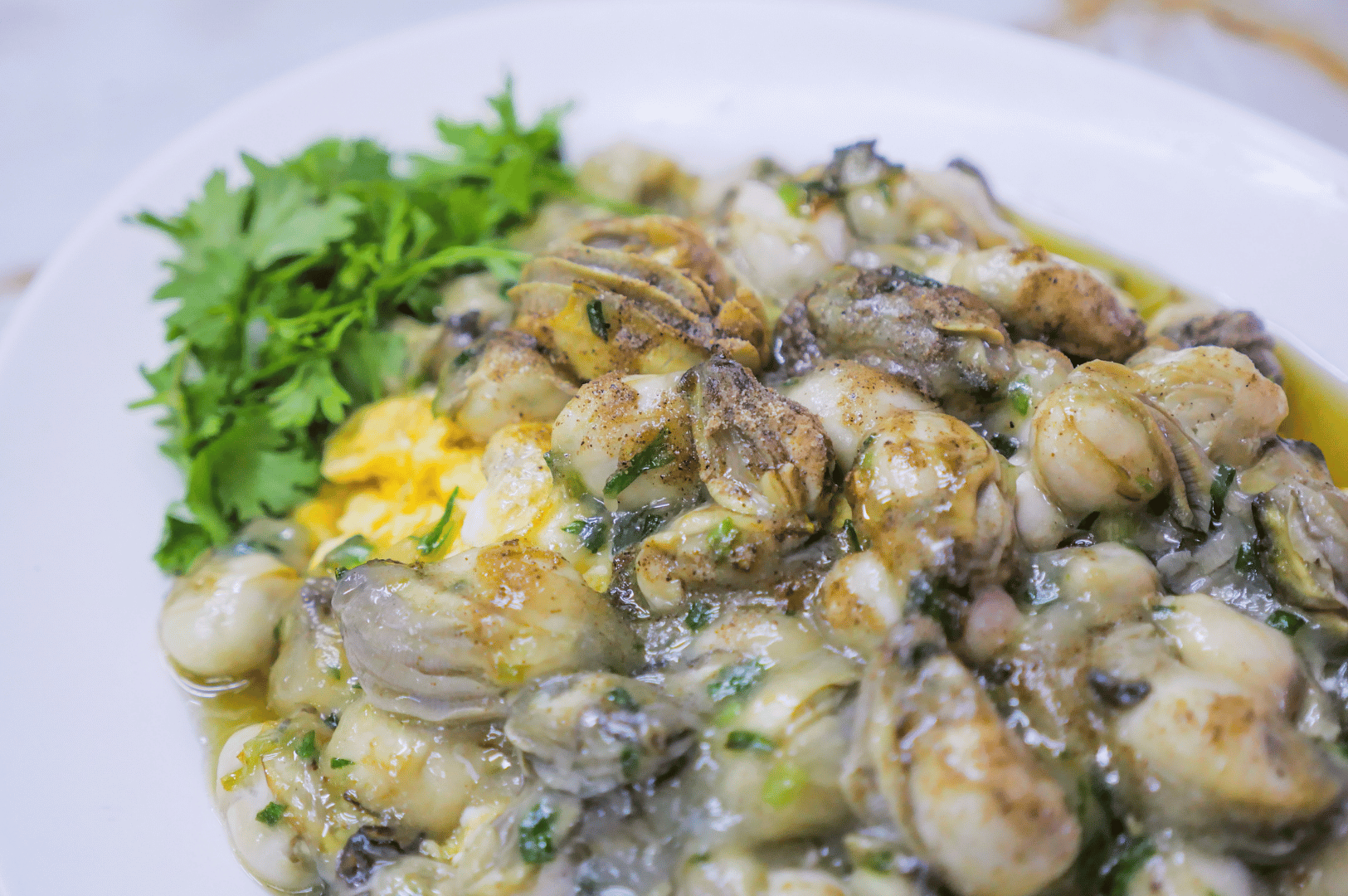
The Taiwanese oyster omelet is a perfect microcosm of Taiwanese cuisine: historical, resourceful, and unapologetically delicious. It’s a dish that brings together contrasting textures and flavors in perfect harmony. From the lively atmosphere of Ningxia Night Market to the sprawling labyrinth of Shilin Night Market, the sizzle of the Oh-ah-jian griddle is a call to all food lovers. It’s a taste of tradition, a sensory adventure, and a true icon of street food excellence. If you’re inspired by rich culinary heritage, explore the Indonesian herbal wellness tradition of jamu or dive into the complex process behind Padang’s famous beef rendang—each offering a unique taste of Southeast Asia’s cultural depth.
Frequently Asked Questions (FAQ)
Q: Is the Taiwanese oyster omelet spicy?
A: The standard savory sauce is not spicy; it's a balance of sweet and tangy. Most street carts will have chili sauce available for you to add to your liking.
Q: I'm allergic to shellfish. Can I still try it?
A: You must avoid the traditional oyster omelet. Due to the high risk of cross-contamination on the shared pan, even an egg-only version is not recommended for those with severe allergies.
Q: What is the "Q" texture I keep hearing about?
A: "Q" is a prized texture in Taiwanese food that describes a satisfyingly chewy, springy, or bouncy mouthfeel. In the oyster omelet, this comes from the cooked sweet potato starch.
Q: How much does an oyster omelet usually cost?
A: It's very affordable. Prices typically range from NT$60 to NT$80 (around $2-$3 USD), making it a perfect cheap eat at any night market.
The Art of Asian Tea Ceremony Traditions: Ancient Rituals and Cultural Values Across Asia
Dio Asahi | November 15, 2025
A cup of tea, in many parts of Asia, represents far more than a beverage-it is a conduit to ancestral tradition, intellectual pursuit, and the cultivation of mindfulness. Asian tea ceremony traditions turn the act of drinking tea into a sophisticated art form, layered with symbolism, philosophy, and socio-cultural values. Each gesture, from scooping powdered…
The Art of Slow-Cooked Curry Recipes: Time’s Magic in South Asian Cuisine
Eda Wong | November 13, 2025
Step into a South Asian kitchen, and the senses are instantly enveloped by the inviting aroma of food slowly simmering in a sturdy clay pot or heavy vessel. The allure is undeniable: in this space, slow-cooked curry recipes are a celebration of patient tradition, spices, and the richness of South Asian cuisine. Here, time and…
Bandung Drink Recipe: A Singaporean Rose Syrup Drink Tradition
Eat Drink Asia Team | November 11, 2025
Step into any night market or hawker centre in Singapore, and you’ll spot a vibrant, glowing glass filled with a cold, beautiful drink-Bandung. Known for its iconic blush-pink hue and refreshing taste, this rose syrup drink is an integral part of Singapore’s beverages scene and a cherished tradition in Southeast Asian gatherings. More than just…
The Ultimate Hainanese Chicken Rice Recipe: A Deep Dive
Eda Wong | November 8, 2025
To wander through Singapore’s bustling hawker centres on a humid evening is to experience a symphony of sights, sounds, and smells. Among the many other dishes sizzling away, one plate stands out for its elegant simplicity: Hainanese Chicken Rice. It arrives without fanfare-gleaming slices of poached chicken over fragrant rice, flanked by a trio of…
Bubble Tea Origins: How Taiwan Created a Global Beverage Phenomenon
Dio Asahi | November 6, 2025
From Taipei to New York, a single drink has captured the world’s taste buds: bubble tea. This beverage, known as pearl milk tea or boba tea, and also known as boba in many regions, is celebrated for its delightful combination of sweet, creamy tea and signature chewy tapioca pearls. What began as a novel creation…
A Food Lover’s Guide to the Taiwanese Oyster Omelet
Eat Drink Asia Team | November 4, 2025
As twilight descends upon Taipei City, a vibrant energy pulses through its streets. This is the hour of the night markets, bustling hubs of community, commerce, and some of the world’s most incredible street food. Amidst the steam from soup dumplings and the sizzle of Taiwanese fried chicken, one iconic dish reigns supreme: the Taiwanese…
Jamu: Indonesian Herbal Medicine for Modern Well-Being
Dio Asahi | November 1, 2025
Across the Indonesian archipelago, a vibrant tradition of herbal healing has flourished for centuries. This is jamu, a cornerstone of Indonesian cultural heritage and a sophisticated system of traditional herbal medicine. Far more than just a refreshing drink, jamu represents a philosophy of balance, a deep connection to nature, and a form of indigenous medicine…
Padang Beef Rendang: The Complex Process Behind Indonesia’s Most Famous Dish
Eda Wong | October 30, 2025
This post may contain affiliate links. For full transparency, this article may contain affiliate links. To call Padang beef rendang simply a dish is to miss the soul of Indonesian cuisine. This legendary slow-cooked dry curry, a centerpiece of both festive tables and humble meals, has earned its fame as one of the world’s most…
Teh Tarik Malaysia: The Art and Science Behind Iconic Pulled Tea
Eat Drink Asia Team | October 28, 2025
In Malaysia, ordering a cup of teh tarik is about so much more than just enjoying a hot drink. Teh tarik, literally translated as “pulled tea,” is Malaysia’s national beverage, famous for its sweet, creamy taste, frothy top, and the spectacular pulling technique seen in bustling mamak stalls and coffee shops across the country. A…
The Legendary Penang Char Kway Teow: A Culinary Journey
Dio Asahi | October 25, 2025
The air in Penang is thick with anticipation, carrying the sounds and smells of Malaysian street food being crafted with expert care. Your attention is captured by one of the many street vendors, a master standing before a seasoned wok glowing over an intense fire. The rhythmic clanging of metal on metal is the soundtrack…

